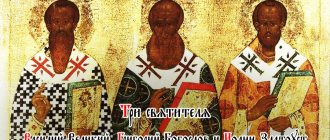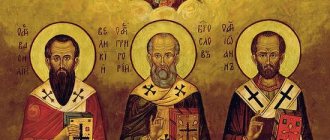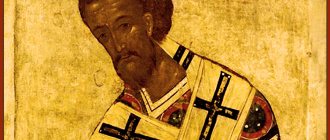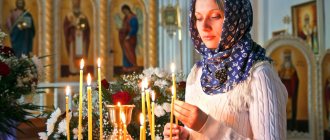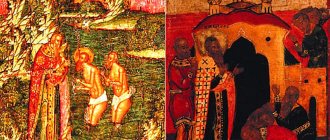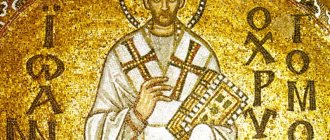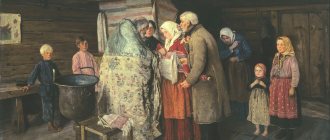| St. Gregory the Theologian |
Gregory the Theologian
(329 - 389), Archbishop of Constantinople, Ecumenical Father and Teacher of the Church, Saint Commemorated January 19, January 25, at the Councils of the Ecumenical Teachers and Hierarchs and the Holy Hierarchs of Constantinople (Greek)
Born into a Christian family of a noble family in 329 in Arianza (near the city of Nazianza in Cappadocia). His father, also Saint Gregory, was the bishop of Nazianium. The mother, Saint Nonna, prayed to God for her son, vowing to dedicate him to the Lord.
He was taught piety by his mother Nonna. He studied secular sciences first in his homeland, with his uncle, the teacher of eloquence Amphilochius, and then in Caesarea Cappadocia, Caesarea Palestine, Alexandria and Athens, where he lived with his famous friend, Basil the Great. The friendship forged in the school of Caesarea grew into deep spiritual bonds. Julian, the future apostate emperor from the Christian faith, also studied with them.
In 358, Saint Gregory left Athens and returned to his parents in Nazianzus. Here, at almost 30 years of age, he received holy baptism from his father. Soon, at the invitation of Saint Basil, he retired into the desert to asceticize next to him.
At the request of his father, Saint Gregory returned to Nazianza in 361 and, against his will, accepted the rank of presbyter. Feeling that solitude and silent prayer were immeasurably closer to him than pastoral activity, Saint Gregory again hurried into the desert to visit Saint Basil. There, in solitude, he strengthened his spirit, found the strength to return to his flock and fulfill his duty with honor.
When his father, out of simplicity, signed the semi-Arian symbol and thereby aroused the Orthodox flock against himself, Gregory appeared as a reconciliator between them and the bishop.
Saint Basil the Great appointed Saint Gregory bishop of the city of Sasima, but in order to support his elderly father, Saint Gregory remained in Nazianza and, after the death of his father, ruled the flock of this city for some time, giving power in Sasima to another bishop.
He then left Nazianzus and retired to Seleucia.
After the death of Emperor Valens II (+ 378), a group of Constantinople Orthodox, who did not want to accept Bishop Demophilus, invited St. Gregory to lead them. Having received the consent of Saint Basil the Great, Saint Gregory arrived in Constantinople to take the primate throne. Heretics dominated everywhere - Arians and Apollinarians. And the louder his preaching sounded, the more the congregation of the temple increased and the stronger the resistance of the heretics grew.
During his illness, the saint was struck. The one he considered his friend, the philosopher Maximus, was secretly consecrated to the place of Saint Gregory in Constantinople itself. Struck by Maxim's ingratitude, the saint decided to leave the see, but his faithful flock held him back. The people expelled the impostor from the city. On November 24, 380, the holy king Theodosius I the Great arrived in the capital and, confirming his decree against heretics, returned the main temple to the Orthodox, where he solemnly introduced Saint Gregory. Soon an attempt was made on the life of the saint, but the one who was supposed to become the murderer himself came to the saint with tears of repentance.
In 381, at the Second Ecumenical Council, Saint Gregory was confirmed in the rank of Archbishop of Constantinople. After the death of Saint Meletius of Antioch, he presided over the Council. But when those who had previously acted against Saint Gregory in favor of Maximus arrived, many, especially the Egyptian and Macedonian episcopate, refused to recognize Gregory’s accession to the See of Constantinople. The saint decided to sacrifice himself for the peace of the Church. Having announced to the emperor his desire to leave the capital, Saint Gregory once again appeared at the Council, asking in his farewell speech to be released in peace. Upon returning to his homeland, he retired to the solitude dear to his heart in Arians.
He died on January 25, 389 and was buried in Nazianza.
For his wonderful theological works, St. Gregory received from the Church the honorary title of Theologian [1] and universal teacher, and for his ability to penetrate with thought to the deepest secrets of faith and express its incomprehensible truths with transparent clarity and strict accuracy, the Church in one of its prayers calls him the highest mind. His sermons are filled with such poetry that many phrases from them were used (by St. John of Damascus and others) for holiday chants.
| Part of the head of St. Gregory the Theologian. Athos. Vatoped |
The first steps on the path of Christian activity
Born in the southwestern region of Cappadocia, in Arianza (near the city of Nazianza), approximately around 330.
He came, in the literal sense of the word, from a family of saints: his father Gregory, Bishop of Nazianza, mother Nonna, brother Caesarius and sister Gorgonia - all of them were canonized after their death.
His own father, Gregory the Elder, at one time he belonged to the supporters of the cult, who worshiped God as the Highest, but at the same time professed a faith consisting of a mixture of Christianity, Judaism and Persian teachings. He turned to Christ through the prayers of his wife, Nonna, a deeply religious and zealous Christian. Under her beneficial influence, he accepted Baptism. He was soon ordained a priest, and subsequently elevated to the episcopal see in Nazianza.
Even before the birth of Gregory the Younger, the future Saint Gregory the Theologian, Nonna fervently prayed to God to give her a son and pledged that if her prayer was fulfilled, she would dedicate the child to God. The son was given, the promise was fulfilled.
From childhood, Gregory the Younger was brought up in love for God and his neighbors. He acquired his initial education, including in the fundamentals of Orthodox doctrine, in his parents' home. Thanks to his mother’s influence, from his youth he decided that he would lead a celibate, godly life.
As he grew up, he studied in the best schools for that time: in Caesarea Cappadocia, in Caesarea Palestine, in Alexandria, in Athens. Education was expensive, but the financial condition of the parents allowed it.
In Caesarea in Cappadocia, Gregory met the future ecumenical teacher, St. Basil the Great. Then their acquaintance continued while studying in Athens and grew into a strong friendship.
Returning from Athens (approximately 358), Gregory received Baptism, after which he indulged in an ascetic life: he spent his life in fasting, prayer, contemplation and contemplation. During this period, he visited Pontus, looking for meetings and joint exploits with his friend and like-minded person Vasily. One of the fruits of their creative collaboration was the work “Philocalia,” which included thoughts and excerpts from the works of the famous church teacher Origen.
Around 360, Gregory the Elder, the father of Gregory the Theologian, not fully understanding the intricacies of the Arian false teaching that had spread by that time, signed the Arian symbol, which aroused the indignation of the Orthodox, representatives of his flock. Many were ready to leave their bishop. At that moment, Gregory the Younger was able to explain to his father his mistake and show the inconsistency of the signed Symbol with the Nicene Symbol. As a result, Gregory the Elder admitted the error publicly and order was restored among his flock.
Proceedings
The theologian is known for the fact that after his death he left many works that are still relevant today. The most significant works of the saint include the following:
- For rich people. Here the saint wrote about people who think only about material wealth and have completely forgotten about spiritual wealth.
- On hypocritical monks. The problem raised here is that some monarchs turned away from the faith and began to think only about themselves and their well-being.
- Parables of Christ. Here the saint wrote about the most famous parables of Jesus.
- Definitions. In this work, the Theologian decided to share the definitions of words that every believer should know.
Priestly and episcopal ministry
In 361, on the day of the solemn celebration of the Nativity of the Savior, Gregory, despite his objections, was ordained a priest. Out of humility, he was against this dedication, but again, out of humility, he did not dare to resist the will of the bishop, his father. Saddened by this turn of events, Gregory went to Pontus, to Vasily. He managed to find the right words of consolation and encouraged his long-time friend.
By Easter 362, Father Gregory returned to Nazians and began to actively fulfill his pastoral duties. From that time on, he was with the flock entrusted to him and, as far as possible, helped his own father, Gregory the Elder, in his bishop's service.
When in 370 Basil the Great was elevated to Archbishop of Caesarea, he, in order to better manage his flock and fight against Arianism, began to open new sees. During this period, he needed zealous, religiously educated shepherds.
Following his plan, Saint Basil appointed his friend, Gregory, bishop of Sasim. The year was 372. Gregory the Theologian, although he understood the importance of this step from the position of Basil the Great, and agreed, however, as in the case of the ordination to the priesthood, he submitted to this choice with reluctance, and then retired to a deserted, deserted place, where he indulged in contemplative prayer .
After some time, Gregory the Elder persuaded his son to come to Nazians. He returned, but on the condition that he would not succeed his father in the department.
In 374, the father of Gregory the Theologian died, and soon his mother. Arriving at the temple where both her husband and her loving son served, and approaching the altar, she suddenly felt the approach of death, said a prayer and surrendered her soul to God. All this, of course, affected Gregory’s internal state. For some time he continued his father’s work, but soon fell ill, so seriously that some did not even hope for his recovery.
In 375, having recovered from his illness, wanting to indulge in solitary living, he retired to Seleucia of Isauria. Here he lived as if he had imprisoned himself. The news of the death of Basil the Great (379) brought him terrible grief.
Iconography
Every church has an icon depicting Gregory the Theologian. On most icons the saint is depicted as a gray-haired old man with considerable bald patches on the front of his forehead. He has a wide and long beard and mustache. He is dressed in a baptized phelonion and holds a scroll with prayer texts and the Gospel in his hands. Some icons dating from the 17th century show him wearing a miter and sakkos.
Sometimes the Theologian is portrayed as the father of the Church and the greatest author of homilies. The first such icons appeared in the 7th century. He is depicted frontally in full height, dressed in felonies. Sometimes the image of St. Basil the Great, who during his lifetime was a close friend of the clergyman, is depicted with him. Most often, such images were used to be placed in the central part of temples. However, sometimes they were placed in other parts of the temple.
The fight against heresy. Literary activity
After the death of Valens, who patronized the Arian “clergy,” Theodosius, who supported the Orthodox, ascended the royal throne.
In 379, the believing citizens of Constantinople turned to St. Gregory with a call for help. Heeding the advice of friends and a sense of pastoral duty, he left solitude and hurried to the capital.
What he saw there led him into a state of righteous indignation: the churches were captured by the Arians, there was no unity within the Orthodox, the morals of the inhabitants were characterized by licentiousness and depravity. Saint Gregory was forced to look for a more or less safe refuge for himself and found it in a private house.
Zeal for the Lord, devotion to Orthodoxy, sober thinking, education and, of course, the eloquence of Gregory the Theologian could not fail to evoke the appropriate response in the hearts of the townspeople. Under the influence of his exhortations and sermons, people were transformed. Many were eager to see and listen to the zealous defender of the faith. Very quickly, the saint’s fame reached such a scale that it began to attract even residents of remote villages to Constantinople.
All this together aroused unfriendly, aggressive feelings among the followers of Arius. The heretics were ready not only to intrigue against the saint, but even attempted to kill him.
The sovereign, Theodosius, who arrived in Constantinople in 380, resorted to the possibilities of his royal power and transferred the churches captured by heretics into the hands of the Orthodox. Saint Gregory, understanding the need for personal presence, agreed to remain in the capital until the planned Council convened.
Prayers
Troparion, tone 1
The pastoral flute of your theology / conquer the trumpets of rhetoricians / as if I had sought the depth of the spirit / and the kindness of the broadcast was added to you. / But pray to Christ God, Father Gregory, / to save our souls.
Kontakion, tone 3
With the theological language of your rhetorical plexus, destroying, more gloriously, / the Orthodox garment, from above, you adorned the Church, / even those who wear it, call with us, your children: / Rejoice, father, // the greatest mind of theology.
The activities of Saint Gregory at the Council of Constantinople
It was this Council, held in 381, which received the status of the Second Ecumenical, that was supposed to put a final point in the dogmatic disputes between the Arians and the Orthodox, which was done.
The Council was attended by such outstanding fathers of the Church as Meletius of Antioch, Gregory of Nyssa and others. Taking into account the wishes of the emperor, the majority of the clergy and ordinary believers, Saint Gregory was elected to the Patriarchal See of Constantinople, and after the death of Meletius of Antioch he was proclaimed chairman of the Council.
But here the Egyptian bishops who arrived at the Council intervened in the matter, wanting to see their protege on the Patriarchal Throne. They aroused controversy, and a suitable motive was found: referring to the canonical rule of the Council of Nicaea, which prohibits the transfer of a bishop from one see to another, they declared the installation of St. Gregory as Bishop of Constantinople illegal.
Despite the fact that the effect of the canon adopted by the fathers of the First Ecumenical Council was blocked by the very election of St. Gregory by the fathers of the Second Ecumenical Council, they clung to this formal pretext. As soon as a favorable ground for the development of intrigue was formed, both those who were dissatisfied with him for his leniency towards the Arians (as lost people) and those who did not want to put up with his severity in the fight for the purity of the faith began to speak out against Gregory.
Saint Gregory, alien to honors, and even more so to vile intrigues, considered it best to renounce his powers as primate of the Church of Constantinople and leave the city. Before leaving, he gave a farewell speech to those gathered, in which he outlined his Christian position and revealed his pastoral correctness.
Constantinople
In the same year and month that Basil the Great died, Theodosius the Great, a supporter of the Nicene people, became emperor. To fight heresy, a good preacher and a convinced opponent of heresies was needed. The fame of Saint Gregory the Theologian as an eloquent and convincing preacher and adherent of the orthodox branch of Christianity reached Constantinople. Several Nicene Christians came to him and asked him to come to the capital to help in the fight against the heretics. Gregory the Theologian agreed and moved to Constantinople.
Unholy Aryan
The saint was depressed by the sight that opened before him. The Arians stayed in the city for about 40 years, all the temples belonged to them. St. Gregory wrote with bitterness that theology is now being practiced by ignorant, uneducated people, who yesterday were engaged in menial labor, but today they are talking with importance about the Incomprehensible. There was no unity among Christians; the behavior of the townspeople was characterized by licentiousness and unbridledness.
Saint Gregory stayed with his relatives and began to serve in the house church, which he called “Resurrection.” Here he wrote 5 essays on theology, for which he received his outstanding nickname.
In “Words on Theology” the saint gave a precise definition of who can do theology with whom and when. According to Gregory the Theologian, experienced ascetics who are enlightened by the Jesus Prayer, who indulge in contemplation, who strive for purification of the soul, and who are pure in body, have the right to reason about God. Saint Gregory points out that God cannot be known by logical conclusions, and knowledge comes when the divine principle (mind) is united with a related Essence - God. As an example of the incomprehensibility of the Lord for the human mind, Saint Gregory the Theologian cites the patriarchs, prophets, and apostles.
From the very beginning of his ministry in Constantinople, the Arians persecuted him, accusing him of polytheism, and more than once trying to deal with him by force. By the grace of God, the saint was not physically harmed and escaped persecution by the city authorities.
In the fall of 380, Emperor Theodosius visited Constantinople and issued a decree transferring the Cathedral of the Twelve Apostles and Hagia Sophia to the Niceans. However, after talking with Saint Gregory, the emperor decided to personally introduce the bishop to the Church of Hagia Sophia.
Emperor Theodosius the Great
The saint described the day of the transfer of Hagia Sophia in an autobiographical poem. Gregory the Theologian recalled that on that day the city was excited, people constantly approached the square near the temple, all the houses were filled with curious people. Screams, sobs and screams were heard everywhere. All this looked like taking the city by storm. The impression was intensified by the many armed soldiers who surrounded the church in a circle.
As soon as Saint Gregory entered the altar, the November sky cleared and the sun came out. The residents of Constantinople took this as a sign from above, and began to demand from Emperor Theodosius that Gregory the Theologian be placed on the patriarchal throne of the city. Such a desire fully corresponded to the plans of the emperor; Saint Gregory also gave his consent. To confirm the saint as patriarch and resolve disagreements caused by heresies, the Second Ecumenical Council, also known as the First of Constantinople, was convened.
The last period of earthly life
Some time later, Gregory the Theologian arrived in Nazianza, headed the local flock there and led it until the moment when Bishop Eulavius ascended to the see of Nazianz. This happened in 383.
After this, the saint moved to his small homeland, Arians, where he devoted himself to prayerful contemplation and writing.
In 389, he rested peacefully in the Lord.
For the holiness and righteousness of his life, the bright, impeccable presentation in his writings of the doctrine of the Most Holy Trinity and the Person of the Lord Jesus Christ, the Ecumenical Orthodox Church honored him with the name of exceptional significance - Theologian. Only three saints entered Church History with this name; besides St. Gregory - Apostle John the Theologian and Simeon the New Theologian.
Saint Gregory the Theologian left behind a rich literary heritage, consisting of 245 letters, 507 poems (sometimes written in imitation of Homer in the forms of hexameters, pentameters, trimeters) and 45 “Words”.
United after death
The memory of each of these saints was celebrated separately before. But, according to legend, in 1084, they all appeared together to Metropolitan John of Euchaitis, nicknamed Mavropod, and testified that they were equal before God. After this vision, the bishop, an outstanding spiritual poet of that time, compiled a common service for them on January 30 (February 12, new style), since the Church remembered all three in this month: Basil the Great - on January 14, Gregory the Theologian - on February 7, and John Chrysostom - on the day of the transfer of his relics, February 9.
Their common pictorial images also began to appear: the first one that has survived to this day is in the Psalter kept in the British Museum, made by the scribe of the Studite Monastery, Theodore, in 1066.
But why exactly did the Cappadocian Fathers and John Chrysostom become the fulcrum for the Church in the tragic 11th century, which split it in two (the Great Schism occurred in 1054 - Ed.)?
Council of Ecumenical Saints; Basil the Great, John Chrysostom, Gregory the Theologian; Russia. Pskov; XVI century
The whole point is that they themselves and the example of their struggle against contemporary heresies were perceived by the Church as a solid foundation of faith, necessary in days of spiritual vacillation and disorder. Especially in a world that, since the year 1000, has been waiting in fear from day to day for the end of the world, predicted in the Revelation of John the Theologian. It turned out that it was these saints who were most in tune with Christians at the turn of the era.
Lyrics
Before turning to Gregory the Theologian in prayer, you need to familiarize yourself with the following prayer texts.
Prayer
Prayer 1
“Oh, most honorable and sacred head and filled with the grace of the Holy Spirit, the abode of the Savior with the Father, great bishop, our warm intercessor, Saint Gregory! Standing at the Throne of all the King and enjoying the light of the Consubstantial Trinity and cherubically with the angels proclaiming the trisagion hymn, having great and unexplored boldness towards the All-Merciful Master, praying for the flock of Christ to save people, establish the well-being of the holy churches, adorn the bishops with the splendor of holiness, strengthen the monastics to the exploits of the good stream, king current keep the city and all cities and countries well, and keep the holy immaculate faith, pacify the whole world, deliver us from famine and destruction, and save us from the attacks of foreigners, comfort the old, instruct the young, make the fools wise, have mercy on widows, protect the orphans, grow up the babies , return the captives, heal the infirm, and everywhere warmly calling you and flowing to you with faith and diligently falling down and praying from all misfortunes and troubles through your intercession, free. Pray for us to the All-Bountiful and Humane-loving Christ our God, so that on the day of the terrible coming of His Holy Standing He will deliver us, and He will create the joys of the saints as partakers with all the saints forever. Amen".
Prayer 2
“Oh, great and wise teacher in all the universe, blessed Father Gregory! Great are your deeds and labors, which you have accomplished for the glory of the Holy Church: you have been a steadfast confessor and a lamp of the faith of Christ on earth, illuminating the faithful with the light of the knowledge of God, scorching false teachings, and proclaiming the word of saving truth to the whole world. Now, having great boldness in heaven towards the Holy Trinity, guide us, who bow to you with humility, to firmly and invariably preserve the holy Orthodox faith until the end of our lives, and guard against lack of faith, doubt and hesitation in faith, so that we will not be seduced by those who oppose God and soul-destroying teachings in words.
The spirit of holy zeal, with which you blazed, O glorious shepherd of the Church of Christ, kindle with your intercession also in us, whom Christ has appointed to be shepherds, so that we may diligently enlighten and confirm in the right faith the verbal flock of Christ.
Ask, O merciful saint, from the Father of lights and everyone, every gift that is useful to everyone: growth for the infant in the Passion of God, chastity for the young, strengthening for the old and weak, consolation for the grieving, healing for the sick, understanding and correction for the erring, intercession for the offended, protection for orphans and widows. , to those who are tempted, grace-filled help, to those who have departed from this temporary life, to our fathers and brothers, blessed repose. To her, Holy One of God, mercifully look down from the Abodes of Heaven on us humble ones, overwhelmed by many temptations and misfortunes, and lead those who are devoted to the earth to the heights of heaven.
Grant us, most good Father, your archpastoral and holy blessing, so that in this new summer and at all other times of our lives we will live in peace, repentance and obedience to the Holy Orthodox Church, diligently doing the commandments of Christ, fighting the good fight of faith, and so We will reach the Kingdom of Heaven, where with you and all the saints we vouchsafe the Holy Trinity, Consubstantial and Indivisible, to sing and glorify forever and ever. Amen".
Prayer 3
“Oh, great saint, Father Gregory, glorious teacher of the Ecumenical Church, all-zealous champion of the glory of the Most Holy Trinity, chosen confessor of the Mother of God and Her Immaculate Virginity, most luminous image of purity, humility and patience. Since I am a great sinner and unworthy of looking up to the heights of heaven, I humbly pray to you, the wise teacher of the Church of Christ, teach me to lead my life in such a God-fearing way, so that I will never take the path that is contrary to God’s command, deviate or be seduced. Protect and deliver me through your powerful intercession from the temptations of the world and the snares of the devil, just as you delivered from them the young man who retreated from our Sweetest Savior and fell into the power of Satan. Grant me the strength of my soul to be a zealous imitator of your lofty virtues: make me more right in faith, firm and unshakable, strengthen the faint-hearted me in patience and trust in the Lord, kindle in my heart the true love of Christ, so that I desire heavenly blessings above all others and enjoy them. Ask me from the Lord for sincere contrition for my sins, so that I will spend the rest of my life in peace, repentance and fulfillment of the commandments of Christ. When the hour of my death draws near, you, O blessed Father, with the Most Blessed Virgin Mary, then hasten to help, protect me from the evil slander of the enemy, and make me worthy of being the heir to be the villages of paradise, so that together with you and with all the saints of God’s impregnable Majesty I will appear before the Throne and I glorify and sing the Life-Giving, Consubstantial and Indivisible Trinity, ever and ever and ever. Amen".
